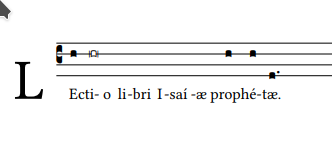How to handle recitations using Gregorio gabc
-
Is there a way in Gregorio to write a reciting note, e.g. (gr0) and not add another note before the first syllable of the ensuing cadence?
I am resetting the St. Matthew Passion (NRSV), so as to include additional openi verses assigned in the Revised Common Lectionary. Entering (j) after every syllable of the recitation is extremely time-consuming and tedious. I used the Meinrad fonts to create my earlier setting, where entering these repeated notes was less so, but these fonts are not compatible with Windows 11. So I am compelled to use Gregorio.
Ideally I would reset the entire passion, but if that proves particularly difficult, would it be feasible
to set just the additional opening verses, create a .pdf, and tack it on to the old setting?
Would it be possible to create a .pdf from a Word document including Meinrad notes? -
Have you experimented with this readings tool? There might be a way to get what you want, but I'm not 100% sure. I have used the (gr0) style for communion verses, abbreviated graduals, alleluias, and tracts, and other psalmody, but I've encountered the opposite problem in doing so: instead of entering a note after every syllable, I've had to delete notes and parentheses. The GABC Transcription Tool on that same site is a bit of a time saver, switching between integrated GABC and separate text boxes as needed, but there's still a lot of manual adjustment to be done. The hyphenator here is also useful, although there are some errors (sanc-tus instead of san-ctus, for example). You will want to put the (gr0) after the last syllable of the recitation, not the first, but you'll have to add another manually where you want/need a line break.
-
If you add a ton of slashes //////////////////////// within the parentheses you can push down the next note or barline that appears.
-
Maybe this? (c4) Pás(h)sio Dómini nostri(jr0) Ie(i)su(h) Chri(j)sti(j)
Also, you can use /[factor] (e.g. /[20]) for spacing.
 reciting-note.pdf17K
reciting-note.pdf17K -
Or, depending on where you want the reciting note to align:
(c4) Pás(h)si(jr0)o Dómini nostri() Ie(i)su(h) Chri(j)sti(j) -
%%
(c3)LEc(h)ti(hr0)o() li()-bri() I()-sa()í()-æ() pro(h)phé(h)tæ.(d.)

 Screenshot_20230311_230726.png332 x 147 - 6K
Screenshot_20230311_230726.png332 x 147 - 6K -
Are more detailed instructions for use of the Reading Tool available? The instructions given solely by way of illustrations are difficult to follow.
-
It’s the ‘r0’ that turns a note into a reciting tone. You’ll note that here chonak has also added infilled parentheses () to continue the chain of text in the reciting tone.
Welcome to the MusicaSacra Forum!
To participate in the discussions on Catholic church music, sign in or register as a forum member, The forum is a project of the Church Music Association of America.
Categories
- All Discussions21,074
- General Music Discussion8,206
- Job Openings193
- Management of Music Programs850
- Choral Matters532
- Church Documents and Rubrics524
- CMAA Notes300
- Events713
- For Newcomers: Read First26
- Sacred Polyphony546
- Hymnody871
- Gregorian Chant: General2,694
- ↳ Graduale Romanum and Liber Usualis367
- ↳ Graduale Simplex60
- ↳ Semiology63
- Vernacular Plainsong696
- Anglican Use and Anglican Chant68
- Organ, Other Instruments and Repertoire434
- New Composition/Works in Progress1,288
- Recordings230
- Music for Hispanic Ministry159
- Music Education: Children211
- Music Education: General222
- News Items245
- Positions Wanted2
- General Discussion: Catholicism738
- Amusements176
- General Discussion1,033
- Opinions117

